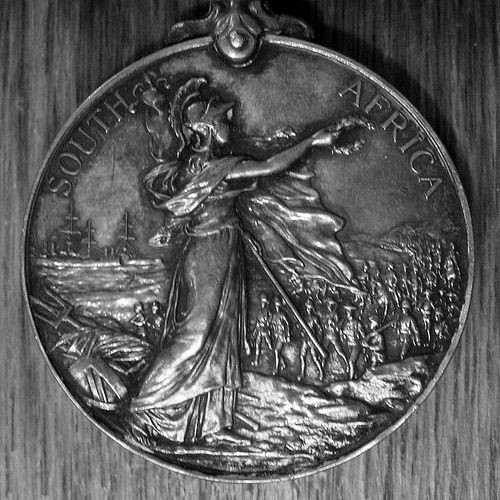Personal Details
Wright Graves Slawson, born in Bevans Yard, Yardington, Whitchurch in 1882, the fourth son of Thomas and Emma Slawson.
Husband of Elizabeth Lily (nee Speed) Slawson of 16a, Yardington Whitchurch; father of Wright Speed, Elsie May, Beatrice, Ivy and George William.
Wright worked as a Farm Labourer before being mobilised in August 1914.
He had been regular soldier and served with the 2nd Battalion King’s Shropshire Light Infantry in South Africa 1899-1902 (Second Boar War) and was awarded the Queens South Africa Medal with 3 Campaign Clasps. He remained a reservist and would have been called up in the general mobilisation in August 1914. He enlisted in Tipperary, Ireland and served in France from 25th March 1915.
Military Details
Regiment : 7th (Service) Battalion King’s Shropshire Light Infantry
Rank : Private
Service Number : 6379
Died of Wounds; France 13th May 1917 Age 35

The Queen's South Africa Medal is a British campaign medal which was awarded to British and Colonial military personnel, civilians employed in official capacity and war correspondents who served in the Second Boer War in South Africa. Altogether twenty-six clasps were awarded to recipients of the Queen's South Africa Medal, to indicate particular actions and campaigns of the Second Boer War.

The 1914 Star (also known as 'Pip') was authorised under Special Army Order no. 350 in November 1917 and by an Admiralty Fleet Order in 1918, for award to officers and men of the British and Indian Expeditionary Forces who served in France or Belgium between 5 August and midnight of 22–23 November 1914. The former date is the day after Britain's declaration of war against the Central Powers, and the closing date marks the end of the First Battle of Ypres.
The 1914–15 Star (also known as 'Pip') was instituted in December 1918 and was awarded to officers and men of British and Imperial forces who served against the Central European Powers in any theatre of the Great War between 5 August 1914 and 31 December 1915. The period of eligibility was prior to the introduction of the Military Service Act 1916, which instituted conscription in Britain.
The British War Medal (also known as 'Squeak') was a silver or bronze medal awarded to officers and men of the British and Imperial Forces who either entered a theatre of war or entered service overseas between 5th August 1914 and 11th November 1918 inclusive. This was later extended to services in Russia, Siberia and some other areas in 1919 and 1920. Approximately 6.5 million British War Medals were issued. Approximately 6.4 million of these were the silver versions of this medal. Around 110,000 of a bronze version were issued mainly to Chinese, Maltese and Indian Labour Corps. The front (obv or obverse) of the medal depicts the head of George V. The recipient's service number, rank, name and unit was impressed on the rim.
The Allied Victory Medal (also known as 'Wilfred') was issued by each of the allies. It was decided that each of the allies should each issue their own bronze victory medal with a similar design, similar equivalent wording and identical ribbon. The British medal was designed by W. McMillan. The front depicts a winged classical figure representing victory. Approximately 5.7 million victory medals were issued. Interestingly, eligibility for this medal was more restrictive and not everyone who received the British War Medal ('Squeak') also received the Victory Medal ('Wilfred'). However, in general, all recipients of 'Wilfred' also received 'Squeak' and all recipients of The 1914 Star or The 1914/1915 Star (also known as 'Pip') also received both 'Squeak' and 'Wilfred'. The recipient's service number, rank, name and unit was impressed on the rim.
Further Information
If you can provide any further information on Wright Graves Slawson please get in touch by leaving a comment below, using our Contact Form or by calling in to Whitchurch Heritage Centre.
Information provided by Terry Evanson Whitchurch, Shropshire and Whitchurch Museum and Archives


